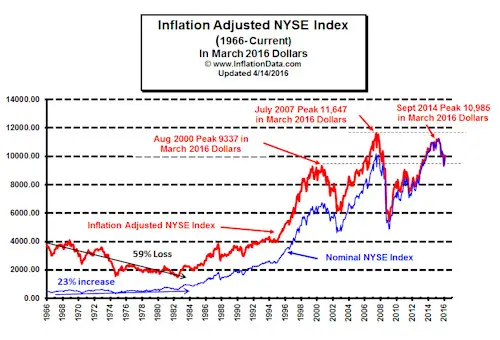ต่อด้วย เมื่อมีเงินเฟ้อที่สูงขึ้น จะกระทบกับผลตอบแทนการลงทุนที่แท้จริงอย่างไรบ้างมีบทความมาให้ดูประกอบพร้อมภาพที่แสดงด้วยครับ และแสดงระดับของผลกระทบของgross profit กับ ระดับของ Inflation ในระดับ ต่ำกว่า เท่ากัน และสูงกว่า เพื่อตอบคำถามว่าทำไม Inflation จึงกระทบกับผลตอบแทนการลงทุน และมีโอกาสกระทบกับความเสี่ยงของราคาหุ้นได้อย่างไรครับ
http://www.inflationdata.com/inflation/ ... _price.asp

What is The True Stock Market Price (Inflation Adjusted)
by Tim McMahon, Editor
Updated July 16, 2010
With the recent Wall Street crash and recovery, how does the Stock Market compare? Where has the stock market really gone over the long run? Or is the upward trend an illusion based on inflation?
Adjusting stock market prices for inflation using the "Consumer Price Index" is known as the Stock price in "real dollars".
(A "real dollar" is the price after adjusting for inflation).
One of the worst problems with inflation is that distorts our perception... things are not always what they seem and this introduces uncertainty into our decision making process.
Here are some various scenarios:
1) The stock market went up 5% a year and inflation went up 3%.
2) The stock market went up 5% a year and inflation went up 5%.
3) The stock market went up 5% a year and inflation went up 6%.
In example #1 above inflation increased less than the stock market so the real return is 5% minus 3% so you had a "real return" of 2% (before taxes and after the inflation adjustment).
In example #2 inflation increased the same as the stock market so the real return is 5% minus 5% so you broke even (before taxes). But after paying taxes on the phantom gain of 5% you will actually lose money.
In example #3 above inflation increased more than the stock market so the real return is 5% minus 6% so you had a real loss of 1% (before taxes). But you will still have to pay taxes on the 5% gain making your real loss even worse.
As you can see the only way to see the true picture is to look at the inflation adjusted prices. We have created several other inflation adjusted price charts including Oil, Gold, Corn, Gasoline and Education.
Now, there are many ways to measure the stock market. The one that most people are interested in and commonly mentioned one by the press is the Dow Jones industrials.
I have often wondered why this index is so widely quoted by economic pundits, (other than the fact that it was originally created on May 26, 1896, making it the first index). At the time the DJIA represented the average of twelve stocks from various important American industries. Today the "DOW" is made up of 30 "representative" stocks and it's composition has changed many times over the last 100 plus years.
Rather than rely on "representative" stock indexes I prefer the real thing so I have created this "inflation adjusted stock price" chart by adjusting for inflation on the entire New York Stock Exchange (NYSE). With the largest dollar volume of any stock exchange in the world and with 2,764 listed securities it gives us a much broader view of the stock market.
Current Commentary:
Let's look at the stock market and see how it has fared this year in real inflation adjusted dollars over the past several years
As you can see from the chart, (above right) the blue line shows the "nominal NYSE index" . To adjust the stock price for inflation we used the Consumer Price Index (CPI-U) which is typically referred to as the "Inflation Rate".
In nominal terms (blue line) the NYSE stock index began 1966 just under 500. And by July of 1982 the nominal stock index had increased to 615 after having been even higher. So on the surface it would appear that the "stock market" posted an increase of roughly 23%.
(615-500=115) and (115 ÷ 500=.23)
Now a 23% increase in 16 years would be a nominal increase of 1.43% a year (less if you consider compounding) which doesn't sound that great, but in those days stocks paid higher dividends than they do today. So investors expected to get their profit from dividends rather than capital appreciation. So most investors would be happy with a 23% increase in their stock portfolio over and above their dividends.
The inflation adjusted stock price
However, when you take off the increase due to inflation, we can see from the red line (which is the "inflation adjusted NYSE Index stock price" in current dollars) that in inflation adjusted dollars the index began 1966 higher and fell through July of 1982.
So rather than a 23% increase, if you count inflation and had held stocks for the 16 years from 1966 to 1982, you would have actually lost about 59% of your purchasing power due to inflation.
But to make matters worse you would have paid taxes on your dividends and "paper gains" further reducing your final remainder. This may be one reason companies began reducing dividends, so more money was pumped into increasing the stock price.
In the time since 1982 the stock market has increased both in nominal terms and in inflation adjusted terms. Interestingly in inflation adjusted terms the NYSE stock index is below the peak of 2000.
The August 2000 stock peak in nominal terms occurred at around 6800 while it is 8546 in inflation adjusted terms.
From the August 2000 peak the market moved higher until the July 2007 peak which was at 10,563 in "real" inflation adjusted dollars. This is a 24.7% increase in seven years or about 3.2% per year (compound interest).
Our NYSE - ROC (Rate of Change) chart tracks the nominal rate of change in the NYSE and gives an excellent visual presentation of stock market nominal rates of return thus making it easier to determine when you should be in the market and when you should be on the sidelines.
